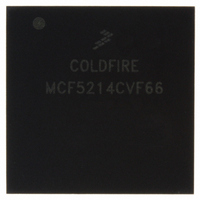MCF5214CVF66 Freescale Semiconductor, MCF5214CVF66 Datasheet - Page 463

MCF5214CVF66
Manufacturer Part Number
MCF5214CVF66
Description
IC MPU 32BIT COLDF 256-MAPBGA
Manufacturer
Freescale Semiconductor
Series
MCF521xr
Datasheet
1.MCF5216CVM66J.pdf
(766 pages)
Specifications of MCF5214CVF66
Core Processor
Coldfire V2
Core Size
32-Bit
Speed
66MHz
Connectivity
CAN, EBI/EMI, I²C, SPI, UART/USART
Peripherals
DMA, LVD, POR, PWM, WDT
Number Of I /o
142
Program Memory Size
256KB (256K x 8)
Program Memory Type
FLASH
Ram Size
64K x 8
Voltage - Supply (vcc/vdd)
2.7 V ~ 3.6 V
Data Converters
A/D 8x12b
Oscillator Type
Internal
Operating Temperature
-40°C ~ 85°C
Package / Case
256-MAPBGA
Package
256MA-BGA
Device Core
ColdFire
Family Name
MCF521x
Maximum Speed
66 MHz
Operating Supply Voltage
3.3 V
Data Bus Width
32 Bit
Number Of Programmable I/os
142
Interface Type
QSPI/UART/I2C/CAN
On-chip Adc
8-chx10-bit
Number Of Timers
8
Lead Free Status / RoHS Status
Contains lead / RoHS non-compliant
Eeprom Size
-
Available stocks
Company
Part Number
Manufacturer
Quantity
Price
Company:
Part Number:
MCF5214CVF66
Manufacturer:
Freescale Semiconductor
Quantity:
10 000
Company:
Part Number:
MCF5214CVF66J
Manufacturer:
Freescale Semiconductor
Quantity:
10 000
- Current page: 463 of 766
- Download datasheet (9Mb)
24.3.4
The transmitter releases the I2C_SDA line high during the acknowledge clock pulse as shown in
Figure
remains stable low during the high period of the clock pulse.
If it does not acknowledge the master, the slave receiver must leave I2C_SDA high. The master can then
generate a STOP signal to abort data transfer or generate a START signal (repeated start, shown in
Figure 24-10
If the master receiver does not acknowledge the slave transmitter after a byte transmission, it means
end-of-data to the slave. The slave releases I2C_SDA for the master to generate a STOP or START signal
(Figure
24.3.5
The master can terminate communication by generating a STOP signal to free the bus. A STOP signal is
defined as a low-to-high transition of I2C_SDA while I2C_SCL is at logical high (see F in
The master can generate a STOP even if the slave has generated an acknowledgment, at which point the
slave must release the bus. The master may also generate a START signal following a calling address,
without first generating a STOP signal. Refer to
24.3.6
A repeated START signal is a START signal generated without first generating a STOP signal to terminate
the communication, as shown in
another slave or with the same slave in a different mode (transmit/receive mode) without releasing the bus.
Freescale Semiconductor
24-9. The receiver pulls down the I2C_SDA line during the acknowledge clock pulse so that it
24-9).
I2C_SDA by Transmitter
Acknowledge
STOP Signal
Repeated START
I2C_SDA by Receiver
and discussed in
I2C_SCL
MCF5282 and MCF5216 ColdFire Microcontroller User’s Manual, Rev. 3
Section 24.3.6, “Repeated
Figure 24-9. Acknowledgement by Receiver
START Signal
Figure
24-10. The master uses a repeated START to communicate with
Bit7
1
Bit6
2
Section 24.3.6, “Repeated START.”
Bit5
3
Bit4
START”) to start a new calling sequence.
4
Bit3
5
Bit2
6
Bit1
7
R/W
Bit0
8
ACK
9
Figure
I
2
C Interface
24-7).
24-9
Related parts for MCF5214CVF66
Image
Part Number
Description
Manufacturer
Datasheet
Request
R
Part Number:
Description:
Manufacturer:
Freescale Semiconductor, Inc
Datasheet:
Part Number:
Description:
Manufacturer:
Freescale Semiconductor, Inc
Datasheet:
Part Number:
Description:
Manufacturer:
Freescale Semiconductor, Inc
Datasheet:
Part Number:
Description:
Manufacturer:
Freescale Semiconductor, Inc
Datasheet:
Part Number:
Description:
Manufacturer:
Freescale Semiconductor, Inc
Datasheet:
Part Number:
Description:
Manufacturer:
Freescale Semiconductor, Inc
Datasheet:
Part Number:
Description:
Manufacturer:
Freescale Semiconductor, Inc
Datasheet:
Part Number:
Description:
Manufacturer:
Freescale Semiconductor, Inc
Datasheet:
Part Number:
Description:
Manufacturer:
Freescale Semiconductor, Inc
Datasheet:
Part Number:
Description:
Manufacturer:
Freescale Semiconductor, Inc
Datasheet:
Part Number:
Description:
Manufacturer:
Freescale Semiconductor, Inc
Datasheet:
Part Number:
Description:
Manufacturer:
Freescale Semiconductor, Inc
Datasheet:
Part Number:
Description:
Manufacturer:
Freescale Semiconductor, Inc
Datasheet:
Part Number:
Description:
Manufacturer:
Freescale Semiconductor, Inc
Datasheet:
Part Number:
Description:
Manufacturer:
Freescale Semiconductor, Inc
Datasheet:











